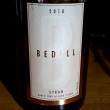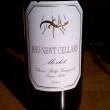Fox Run Vineyards 2005 Reserve Cabernet Franc
 I mentioned earlier this week that I've been impressed by some 2005 Finger Lakes cabernet francs. Well, this is the one that I liked best in that recent blind tasting.
I mentioned earlier this week that I've been impressed by some 2005 Finger Lakes cabernet francs. Well, this is the one that I liked best in that recent blind tasting.
From the moment I pulled the cork, I knew this wine was going to be interesting. Once in my glass, complex aromas of camp fire, black pepper bacon, sweet vanilla, cocoa powder and intense black fruit fill the room. When I re-tasted this wine the next day, the smokiness had stepped back a bit, with fruit coming to the forefront and subtle herbal qualities emerging.
Smoke and spice lead on a palate that is medium-to-full weight, but rich, mouth-filling black raspberry and blackberry flavors follow closely. The finish is very long, lingering with distinct notes of basil and thyme.
By the second day, the basil and thyme notes had woven their way throughout the wine, with more black pepper spice showing as well.
This is definitely more a Bordeaux-style cab franc, as opposed to Loire. It's also one of the best Finger Lakes reds I've had.
Producer: Fox Run Vineyards
Grapes: 77% cabernet franc, 15% merlot, 8% cabernet sauvignon
AVA: Finger Lakes
ABV: 12%
Price: $40
Rating:
(3.5 out of 5 | Very good-to-Delicious).
(Ratings Guide)

















Scott Osbourn offered this wine when Georg Riedel was visiting, and it was very impressive and well-received at dinner. I featured it in my post on that event.
Case in point, reds CAN be good ambassadors of the Finger Lakes, and I believe that variances in vintages notwithstanding, the overall quality of red production is improving year after year.
Jason: I agree, but let’s not downplay the importance of vineyard variation in cooler climates like the Finger Lakes or even Long Island.
It’s important, if not from a quality standpoint, a style standpoint. I think that good reds are possible in the Finger Lakes, even in cooler years (see the 2006 Billsboro Cab Franc as an example) but stylistically, they have to differ from this wine. Without ripe, rich fruit, this wine would be way out of balance.
I couldn’t agree more about having to respond to the cooler vintages in terms of approach and style. I think the general rise in quality has come about because a few more producers seem to be able to respond to cooler vintages by finding proper balance. While a lot of 2006 reds aren’t quite there, some are, which is impressive and shows long-term potential for the region.
An ’05 or ’07 is an easier prospect, to be sure, but it’s certainly worth noting that even in warm years in the past the quality or potential of reds might not have been as apparent in as many wineries as it is today.
It is so much more fun to disagree with you guys. But you’re spot on with this.
Lenn, when I volunteered to pour on Fox Run’s hectic fall weekends, this was a very interesting wine to pour in the tasting room. The customers asking to try dry reds were stunned with it, and while some recoiled at the price tag, they were encouraged about where the region is heading. I describe this as the perfect “Tuesday night wine.” Had a crappy day at work? Don’t feel like waiting for the weekend to open something a little nicer than usual? This is the choice.
Let’s just make clear that there are plenty of bad reds from 2005 and 2007. Strong weather years does not guarantee anything. Jason’s point about improving winemaking quality across the board is spot on.
I am still hunting for more than a small handful of good 2006 FL reds. When discovering good reds in bad weather years (in any region of the winemaking world), it’s certainly exciting.
Evan: What are some of those 2006s that you’ve enjoyed? Would love to hear your favorites.
This is a very nice wine and one that really stood out amongst a solid-to-good group of 05 reds.
I’m truly jealous that I haven’t tried this wine yet. I often wonder what the difference is in the fruit that makes up NY reserve reds as opposed to the non-reserve.
Are they restricted yields in the vineyard for the reserve stuff?
Is this stuff manically sorted before vinified?
Are they just picking the best barrels to make this blend?
$40 is up there and they must have plenty of confidence that people will pay for it based on taste, or is the price based on the cost of dropping fruit or sorting to enhance ripeness?
Anyone familiar with how it was made?
Bryan,
This should help.
http://www.nysaes.cornell.edu/fst/faculty/acree/fs430/notes_bell/pdf/Reserve.doc
Every winery has their own view on Reserve wines (Ravines, for example, does not make reserve wines and the winemaker finds little value in the term). This piece is written by Fox Run’s assistant winemaker, so it’s a good window into how they come to their reserves.
Bryan,
Further to Evan’s comment, I will endeavor to answer your questions about how this wine came to be made, sometime in the next day or two.
oh man, you know how I love Cab Franc - it sounds awesome, save me a bottle man!
More on how this wine was made:
CF tends to crop very heavily most years, and often cluster removal is necessary. We did a bit in 2005. No sorting before crushing. Three different yeast strains were used.
Grapes from our different CF blocks were fermented and aged separately,for the precise reason that there might be some exceptional material in there somewhere.
This was the case with the 2005 Reserve. We were tasting through 90 or so barrels of Bordeaux varieties reds, and encountered 6 CF barrels that had exceptional aroma and texture. These became our first and so far only Reserve CF.
The wine was almost intolerably oaky for the first year or so after bottling, but luckily we were not in a hurry to release it since there was so little of it anyway.
I hope this answers your questions.
Peter: Thanks for sharing that information. Can you tell us a bit more about the barrel program? How much new oak? Origin?
Did you (or will you) make a reserve cab franc again from 2007?
Peter
Thanks for your reply!
I’m really intrigued about your yeast selection. Did one yeast outshine the others enough to dominate this blend?
are there yeast catalogs? you know, like a seed catalogs? whats a good place to order different yeasts?
The oak that this wine was aged in was mostly 2-3 year old Virginia oak from Nadalie. One barrel had Stavin inserts (long sticks of toasted oak that are inserted into the bunghole to refresh an older barrel).
No Reserve CF from 2007. It is good, but a lot less complex, since I aged it in stainless steel for the most part.
My go-to yeast for Bordeaux reds is GRE from Lalvin. I love how it dials up the fruit. The other two (also Lalvin products) added licorice and jammy/spicy characters. They were all fermented separately, of course.
Yes, there are yeast catalogs. Google “Scott Labs”.
If anyone wants to taste this wine along with some phenomenal food this Thursday night, we still have a few tickets left for the Fox Run Winemaker Dinner featuring Peter Bell at the New York Wine & Culinary Center in Canandaigua, NY. Click here for more info: http://www.nywcc.com/learn/program_schedule_prod.php?id=42
It will be served with the fourth course: House-made lamb sausage with wild mushroom ragout